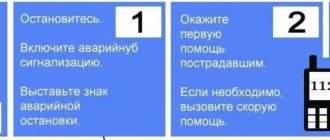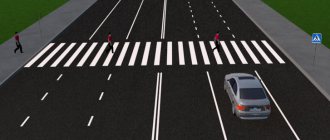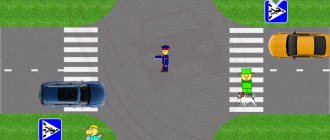When does it make sense to reconcile with the victim?
Reconciliation of the parties is a non-exonerating basis for terminating a criminal case, that is, the driver will be considered guilty of committing a crime.
This information remains forever in the forensic records of law enforcement agencies' information databases.
Such information is formally considered confidential, but in practice it is available to the security services of banks and future employers.
It follows from this that you should reconcile when your guilt in an accident is absolutely obvious, and it is impossible to prove your innocence.
It is also necessary to take into account the adequacy of the victims’ demands, which have recently tended to increase. If, during competent negotiations, the amount of compensation for harm was reduced to an acceptable amount, then you should go for reconciliation in order to receive positive preferences for yourself, indicated below. If you are not guilty of an accident or the demands of the victims are inadequate, then you should apply the methods of defense described in the article Criminal cases in road accidents.
What are the benefits of terminating a criminal case in connection with reconciliation with the victim?
Reconciliation presupposes the absence of criminal liability for the crime committed. The accused will not be punished for the act committed. Accordingly, the court will not assign him either imprisonment or a suspended sentence. A significant advantage of reconciliation is the preservation of the right to drive a vehicle (if convicted, the driver is deprived of this right for up to three years). Moreover, the issue of compensation for harm caused to the victim in an accident is being resolved, since reconciliation involves making amends to the victim.
Under what conditions is a road accident case terminated upon reconciliation of the parties?
Reconciliation of the parties is possible if the following conditions are met: firstly, the crime was committed for the first time, secondly, the crime committed is of minor or moderate gravity (note that all parts of Article 264 of the Criminal Code of the Russian Federation fall under this condition), thirdly, the accused has reconciled with the victim and made amends, in other words, compensated for the moral and material damage caused.
A necessary condition for reconciliation is the victim filing a petition for reconciliation and personal presence at the court hearing. Personal presence is required to confirm the fact of reconciliation, its voluntariness, and compensation for harm.
Reconciliation of parties in case of — road accident with — victims
A person who has committed a crime of minor or medium gravity for the first time may be released from criminal liability if he has reconciled with the victim and made amends for the harm caused to the victim. This article will discuss the procedure for reconciliation of the parties , which allows the driver to avoid liability for a violation:
Above it was said that reconciliation is possible only in the case of crimes of minor or moderate gravity. To decipher these concepts, let us turn to Article 15 of the Criminal Code: 3. Crimes of medium gravity are recognized as intentional acts, for the commission of which the maximum penalty provided for by this Code does not exceed five years of imprisonment, and careless acts, for the commission of which the maximum penalty provided for by this Code Code, exceeds three years of imprisonment.
This article talks about the fact that all careless acts are recognized as crimes of minor or moderate gravity .
How it's done?
Reconciliation of the parties is carried out, as a rule, on the initiative of the defense attorney. Reconciliation is preceded by negotiations between the defense attorney and the victim or his representative (lawyer or relatives) and agreement on the amount of payment. This stage of work is the most important, since the amount of payment to the victim ultimately depends on the skills and abilities of the defender. In the interests of the accused, the amount should be minimal, but, in general, when calculating, it is necessary to focus on the approximate cost of treatment and the amount of moral compensation. It should be noted that recently the amount of compensation for moral damage determined in civil or criminal proceedings (when considering a civil claim) has tended to increase significantly. The task of the defense attorney at this stage is that he must explain that it is better to get less, but immediately, than to have a long trial, first in a criminal trial and then in a civil trial.
When a certain agreement has been reached between the parties, one should proceed to the stage of its formalization. Registration options depend on the method of payment of the amount of money. Thus, with a one-time payment, registration of receipt of funds is possible by drawing up a receipt. If the amount is significant and it is not possible to pay it immediately, then the parties can agree on phased payment of the agreed amount. In this case, the parties enter into an agreement in which they indicate the stages of payment.
As noted above, reconciliation is carried out at the request of the victim. The petition can be filed at the investigation stage of the case (which is desirable). In this case, at the end of the case, you can apply for a preliminary hearing.
If for some reason a petition was not filed during the investigation, then it can be submitted directly at the court hearing. Since the satisfaction of the petition significantly affects the rights of the victim, the latter must appear in person at the court hearing and explain to the court about his voluntary intentions to reconcile, the absence of pressure from the accused, the fact of confirmation of payments and actual reparation. If a pedestrian died as a result of an accident, charges are carried out under Art. 264 part 3 of the Criminal Code of the Russian Federation, the victim is present at the court hearing - a relative of the deceased, who is recognized as such by a resolution of the investigator or a court ruling. Please note that personal presence is the most important factor determining the success of this process.
Having found out that the reconciliation is voluntary, the court dismisses the case due to the reconciliation of the parties.
What does judicial practice say?
Proceedings in court regarding fatal accidents are the most difficult, since in such cases it is not easy to determine the culprit of the accident. Such accidents often occur not only as a result of a collision between vehicles or a pedestrian, but also due to:
- damage to the road surface;
- lack of road markings or signs;
- installation of defective parts;
- negligence committed by third parties (for example, a poorly secured pole falling onto the road).
In such situations, a large number of technical examinations are required to identify violations committed by builders, service organizations, and the manufacturing plant, which may be related to the death of a person. Consideration of such cases in court often takes a long time, proceedings last for years.
https://www.youtube.com/watch?v=ytaboutru
Note! The types of punishments that can be applied to responsible persons are defined in Art. 293 of the Criminal Code of the Russian Federation.
What to do if it is not possible to pay the victim the entire amount they require?
If it is not possible to pay the entire amount to the victim, it is possible to pay the amount in installments. The main task in such a situation is to reach an agreement with the victim on reconciliation with subsequent payment. Otherwise, the victim may refuse reconciliation. When making payments in stages, the parties sign an agreement. The agreement, like any other agreement, is drawn up in writing (simple or, at the request of the parties, notarial). The agreement contains the passport details of the parties, information about the place of residence and other contact information. The agreement specifies the total amounts of material and moral damage, terms and amounts of payments. As noted above, deadlines are set by agreement of the parties and may be later than the court date. An indication of the fact of reconciliation and other conditions that the parties consider important are required.
Step-by-step instructions for drawing up a Settlement Agreement in case of an accident
The Civil Code does not contain rules for drawing up a settlement agreement. There is no standard form either. However, the list of mandatory information that must be present in a judicial and pre-trial settlement agreement in case of an accident, as well as the specifics of filling out the document, are given in Article 140 of the Arbitration Procedure Code of the Russian Federation. It states that information must be reflected strictly in writing. The document is signed by the participants in the incident themselves or their representatives. If the action is performed by a third party, the citizen must have the authority to conclude a settlement agreement. To transfer them, a power of attorney must be issued.
A settlement agreement in case of a traffic accident contains information about the conditions, amount and timing of the obligations of one party to the other. The paper can include nuances about deferment or installment payment, assignment of claims, full or partial forgiveness or recognition of debt. All reflected norms must not contradict current legislation.
The document is drawn up and signed according to the number of persons who entered into the agreement. If the trial has already begun, but the citizens were able to reach an agreement on their own, an additional copy is provided to the court. She joins the case materials.
The amount of compensation is fixed in figures and words. Letter spelling will take precedence if data is inconsistent. Sometimes there may be a link to documentation on the basis of which the amount of compensation is determined.
If the parties plan to resolve the situation without going to court, it is recommended to sign the paper with 2 witnesses. They also put their signatures on the paper.
It is better to enter data by hand. Action is necessary in case of a possible handwriting examination, which will make it possible to find out who wrote the paper and when.
It is important to take into account the psychophysical state of the opponent. If he is unwell or drunk, the settlement agreement for an accident may be annulled in court. It is recommended to have the agreement certified by a notary and to involve a psychiatrist in the proceedings who can confirm that the participants in the procedure are of sound mind, are fully aware of their actions and voluntarily sign the paper. Filling out a settlement agreement in case of an accident is carried out according to the following scheme:
- The data is entered into the document header. Initially, the name is indicated, the date is entered, and information about the participants in the incident is recorded.
- The essence of what happened is recorded. It is important to reflect the location of the accident, information about the cars based on the registration certificate, data on the grounds on which the persons received ownership of the car.
- Indicate the amount of damage caused and the period for providing compensation.
- The responsibilities of the participants in the procedure are prescribed.
- The addresses of the parties are recorded. The culprit and the victim sign.
a settlement agreement in case of an accident can be found here.
A blank settlement agreement for an accident is located here.
What are the benefits of reconciliation?
The main advantage of reconciliation is that the criminal case will be dismissed and, therefore, the accused will not change his procedural status to a convicted person. During reconciliation, the court does not impose any punishment, including a suspended sentence, and there will be no criminal record. An additional punishment - deprivation of rights - is also not imposed (after 10 days, if neither party or the prosecutor has filed complaints, the driver takes the driver's license from the court secretary). Moreover, determining the amount of payment to the victim will protect the defendant from the possibility of the victim filing a civil claim for damages. If reconciliation has not been achieved, then in a civil suit, we will be talking about more significant amounts. Thus, according to the Civil Code of the Russian Federation, expenses for treatment (if it could not be provided within the framework of compulsory medical insurance), lost earnings, moral damage (the amount of which is significant), and costs for lawyers are subject to compensation.
Causing grievous bodily harm in an accident
Road accidents are considered a common occurrence, and only some of them entail consequences in the form of damage to the health of passengers. Damage from accidents can be both physical and moral. Severe injuries to participants in road accidents are less common than others, and at the same time require more detailed consideration from a legal point of view. You need to know how to defend your rights and ensure that the inconvenience caused is fully compensated.
Based on the calculation of the amount of moral compensation assigned when rendering a verdict in cases involving road accidents, it can be concluded that moral compensation is one of the lowest types of compensation.
As judicial practice shows, the amount of compensation is very small. With this money it is impossible to conduct a full examination of the psychological state of a person involved in an accident.
The court softened the terms of punishment for persons who had not previously been convicted and did not violate the law, and for those who had already been convicted in similar cases or more serious ones, the court made stricter decisions. Reconciliation of the parties in an accident is the best option for avoiding liability.
The culprit accepts the blame for what he has done, but does not receive any sanction orders regarding compensation for damage. Reconciliation implies in the documentation the presence of an admission of guilt by the accused party. This data will be visible to the employer, the bank from which the citizen decides to take out a loan, as well as in various other cases, despite the fact that such information is considered private. Responsibility for a given criminal act is determined by a judge, taking into account all the circumstances of the case.
For example, data from a video recorder greatly facilitates the trial process, because such data is direct evidence of the guilt or innocence of one of the parties. All options for assistance and a special regime for compensation for damage by the criminal are strictly individual and different for each individual case. If the victim does not agree with them, then the application for reconciliation of the parties is rejected and the criminal process is resumed. The key reason is that criminal prosecution of the offender ceases after a settlement is reached.
Re-initiation of a criminal case on the same issue is excluded.
How do other participants in an accident who are not recognized as victims influence reconciliation?
Recognition as a victim is carried out by the relevant decision of the investigator. As part of a criminal case on charges of committing a crime under Art. 264 of the Criminal Code of the Russian Federation, a victim is recognized as a person who has suffered serious harm to health as a result of an accident, or, in the event of the death of a pedestrian, relatives are recognized as victims. Other participants in an accident in a criminal case, who did not suffer serious harm to health, or whose vehicle was damaged, are witnesses and therefore cannot influence the reconciliation. The accused does not reconcile with these persons, their opinion is not taken into account. Such persons are not called to preliminary hearings. If other persons involved in the accident are not recognized as victims, then they have the right to file a civil claim in a separate process, but this process is complex and lengthy, and less fundamental than criminal liability.
How can death in an accident be interpreted?
A death in an accident can be regarded as murder if it is proven that the perpetrator committed intentional acts against the victims. If it is proven that the accident was not caused by accidental circumstances, then the car will be equated to a murder weapon.
https://www.youtube.com/watch?v=ytpressru
The strictest penalties are applied in accordance with Art. 105 of the Criminal Code of the Russian Federation. This norm describes situations of committing crimes against a person, for which punishment is provided in the form of imprisonment for a period of 6 to 15 years.
In most cases, fatal accidents occur as a result of accidental circumstances. Therefore, when considering such cases, the actions of drivers are regarded as murder by negligence. Since the culprit knew about the consequences, but he did not take actions to prevent the accident, or he took actions, but they turned out to be ineffective.
Can there be problems with insurance payments during reconciliation?
Every road user is required to be insured. Based on this, the victim can contact the insurance company with a claim for compensation for the harm caused. When initiating a criminal case under Art. 264 of the Criminal Code of the Russian Federation, in order to receive payment, the victim must provide the insurance company with a court verdict or a resolution to terminate the criminal case, which clearly identifies the person responsible for the accident. When a criminal case is terminated, the court issues a ruling stating that the material damage is fully compensated by the culprit. When the victim contacts the insurance company, he will most likely be denied payment, since all the damage has already been compensated. Therefore, if the victim intends to appeal to the insurance company, the following should be indicated at the court hearing: firstly, the driver has compensated for moral damages, secondly, the damage caused by the crime has been completely made up for, thirdly, the victim intends to apply for compensation for material damage to the insurance company and do not have any other material claims against the driver.
However, for the driver, such a situation is risky, since having reached a certain agreement and paying the victim money, the driver may be faced with a situation where the court refuses to terminate the criminal case due to the reconciliation of the parties, since the basis for termination of the case is, among other things, full compensation for the harm caused.
Accident by agreement
A certain Popov in the city of Langepas drove to the side of the road and rammed a car parked there, driven by a certain A. As a result, A. was seriously injured, and a criminal case was opened against Popov under Part 1 of Article 264 of the Criminal Code. Popov admitted his guilt in the accident and made every effort to reconcile with the victim. He even paid him 480 thousand rubles - this compensation was established by the victim himself. Ultimately, Popov managed to come to an agreement with the victim. As a result, the victim himself petitioned the investigation to terminate the criminal case against Popov precisely for the reconciliation of the parties. And investigators closed the case in June of the same year.
The indication that the decision to terminate the case in connection with the reconciliation of the parties is a right and not an obligation of the court, according to the Supreme Court, is illegal
However, the prosecutor's office returned him for further investigation. But not because there were no grounds for reconciliation. The prosecutor considered that not all circumstances to be proven had been established. In particular, the possibility of creating an obstacle in front of Popov, due to which he pulled onto the side of the road, has not been explored. This circumstance would have made Popov completely innocent of the accident.
In court, the victim again petitioned to release Popov. However, the court did not satisfy this petition and convicted Popov. The culprit of the accident was sentenced to 1 year and 4 months of restriction of freedom, with deprivation of rights for 1 year and 4 months imposed as an additional punishment.
At the same time, the court explained its refusal to apply conciliation by the fact that Popov had previously been brought to administrative responsibility for violating traffic rules, that Popov’s payment of 480,000 rubles to the victim was not full compensation for harm from the crime, and also indicated that what Popov had done encroaches on life and human health and on the safety of traffic and operation of transport and thereby creates an increased public danger for others.
The court of appeal agreed with the court of first instance, as well as the presidium of the court of the Khanty-Mansiysk Autonomous Okrug - Ugra.
But the Supreme Court disagreed. He indicated that, based on the provisions of Article 76 of the Criminal Code, release from criminal liability in connection with reconciliation with the victim is possible if the conditions specified in this article are met. One of these conditions is reconciliation between the person who committed the crime and the victim and making amends for the harm caused to him. And by making amends for harm we should understand compensation for damage, as well as other measures aimed at restoring the rights and legitimate interests of the victim violated as a result of the crime. In this case, the methods of making amends for the harm, as well as the amount of compensation, are determined by the victim.
Popov admitted guilt. It was the first time he committed a crime of minor gravity, and he fully compensated for the damage caused, determined by the victim. He also apologized. The victim stated that he had forgiven Popov, reconciled with him and did not want to bring him to criminal responsibility. Thus, all conditions for Popov's release have been met.
In response to the fact that Popov had previously been brought to administrative responsibility, the Supreme Court recalled that a person is considered subject to it for a year. At the time of the first court hearing, the statute of limitations had passed.
As for incomplete compensation - in particular, the court of first instance pointed to the state of health of the victim, requiring additional costs in the future exceeding the compensation paid - the Supreme Court recalled that the amount is determined by the victim at the time of making a procedural decision to terminate the criminal case.
And the indications of the courts of the first instance, as well as the cassation instance, that making a decision to terminate a criminal case in connection with reconciliation with the victim is a right and not an obligation of the court, in the opinion of the Supreme Court, were made without taking into account the requirements of legality, validity and fairness of the court decision.
Based on all this, the Supreme Court panel overturned the decisions of the lower courts and dismissed the case pending reconciliation of the parties. In general, if the culprit and the victim have truly reconciled, then the rest can only come to terms with it.
But it must be recalled that a few years ago it was proposed to exclude the possibility of reconciliation in a situation where the victim died in an accident. Indeed, in this case, it is not the victim who is reconciled, but his relatives. Who knows what kind of relationship they had?
The State Duma proposed banning the use of gadgets while driving:
What to do if you cannot reconcile with the victim?
If the victim refuses reconciliation, then the elements of protection specified in the article Criminal cases in road accidents should be used, the case will be considered by the court, and the appropriate sentence will be passed. As part of the criminal process, the victim can file a civil claim for recovery of treatment costs, lost earnings, and moral damages.
In this case, it is necessary to reduce the amount of compensation as much as possible and try to transfer the consideration of the claim to civil proceedings. Only a qualified accident lawyer can do this correctly.
In any case, before the trial, the accused is strongly recommended to pay some amount to the victim, which will be assessed by the court as a mitigating circumstance. These payments can be made regardless of the recognition of guilt in a crime, since the owner of the vehicle (a source of increased danger) bears civil liability regardless of the guilt of his actions.







